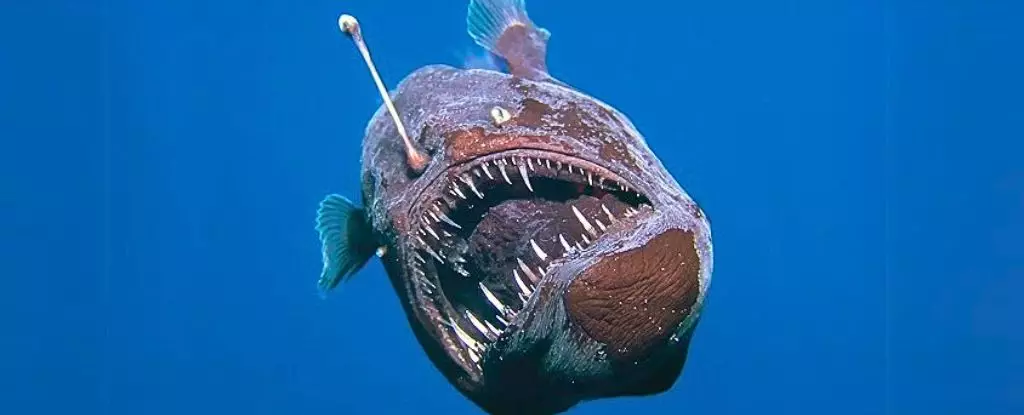In a groundbreaking moment for marine biology, researchers from Condrik Tenerife made an extraordinary discovery just off the shores of Tenerife Island. While their initial mission focused on tracking sharks, they encountered a living specimen of the elusive humpback anglerfish (Melanocetus johnsonii)—a creature usually hidden in the depths of the ocean, far from human eyes. The dramatic footage captured by photographer David Jara Boguñá shared this marvel of nature with the world for the first time in natural daylight. This revelation stirs more than mere scientific curiosity; it reflects a long-overdue shift in our perception of the mysterious deep sea.
The humpback anglerfish’s appearance at such a shallow depth, typically its environment being between 200 and 600 meters, raises intriguing questions about its motivations. Many have speculated that this uncharacteristic behavior could stem from illness or other environmental factors, yet the ambiguity adds to the fish’s haunting allure. On the surface, its presence sparked a surge of empathy and admiration from social media audiences who galvanized around this lone swimmer, sometimes describing it as a feminist icon or an allegorical figure reminiscent of Icarus.
Reframing Perspectives on Deep-Sea Creatures
Traditionally, the narrative surrounding deep-sea inhabitants, especially anglerfish, is woven with threads of fear and misunderstanding. Portrayed as grotesque harbingers of the abyss, these creatures evoke images of alien horrors lurking in the ocean’s darkest corners. However, the viral response to this particular anglerfish suggests that perhaps our perceptions are beginning to evolve. Many have embraced it as a symbol of resilience, describing it as a courageous figure—one that dared to ascend towards the light only to meet its untimely demise.
This positive reimagining marks a significant cultural shift. We humanize the anglerfish, projecting our own myths of striving and sacrifice onto an entity that knows nothing of our societal complexities. Indeed, it speaks volumes that the fish has been dubbed “Icarus” in popular discourse, embodying both aspiration and tragedy. If anything, this reframing highlights a burgeoning empathy toward creatures traditionally viewed as monstrous.
The Role of Bioluminescence in Nature and Narrative
What makes the anglerfish remarkable beyond its dive-related behaviors is its bioluminescent lure—a fascinating adaptation involving symbiotic bacteria that glow to attract prey in an environment where light is a foreign concept. This evolutionary marvel enhances the fish’s role as one of the deep sea’s prime predators, a predator that has been both feared and underappreciated.
The allure of the anglerfish extends beyond biology into environmental consciousness. By invoking emotions tied to beauty, tragedy, and the fight for survival, this fish compels us to consider the fragility of life beneath the waves. In facing an ecological crisis exacerbated by human activity, it serves as a poignant reminder of how fragile ecosystems fester in darkness, often unnoticed until tragedy strikes.
Popular Culture’s Role in Shaping Perceptions
Historically, cinema has contributed to the public perception of deep-sea creatures like the anglerfish. From their representation as antagonists in animated films like “Finding Nemo” and “Luca” to their alien-like depictions in works of fiction, these portrayals condition society to view these creatures not simply as grotesque entities, but increasingly as enigmas worthy of fascination. The viral video featuring the humpback anglerfish propelled this narrative further, enabling discussions that intertwine science and philosophical musings about existence and identity.
The internet burst forth with creative expressions inspired by this fish, encapsulating an empathy for beings typically relegated to horror stories. Even those who have disparagingly nicknamed the blobfish—often regarded as the “ugliest animal”—continue to reinforce societal biases about beauty and worth. In contrast, the anglerfish’s resurgence as an emotive icon demonstrates a yearning for connection that transcends mere aesthetic judgments.
Advocacy Through Empathy
As society grapples with the implications of climate change, plastic pollution, and ecological degradation, the broad empathy generated for Icarus the anglerfish suggests a powerful avenue for advocacy. Instead of relegating marine issues to the realm of abstract environmentalism, we can see how personal connections with these creatures inspire real change.
Certainly, the emotional ties we forge with the deep sea can galvanize efforts to understand and protect marine ecosystems. While oversimplifying their struggles can lead to distortions in scientific discourse, the benefits of fostering curiosity about these foreign habitats are undeniable. As voices call for marine conservation, we must balance our fascination with animal behaviors against the pressing environmental responsibilities they inspire.
The emergence of the humpback anglerfish from the shadowy depths reveals much about our values as a society and our complex relationship with the ocean. It highlights our need for connection and understanding in both scientific and emotional realms, inviting us to explore the beauty of the unknown while acknowledging our role in its preservation.

